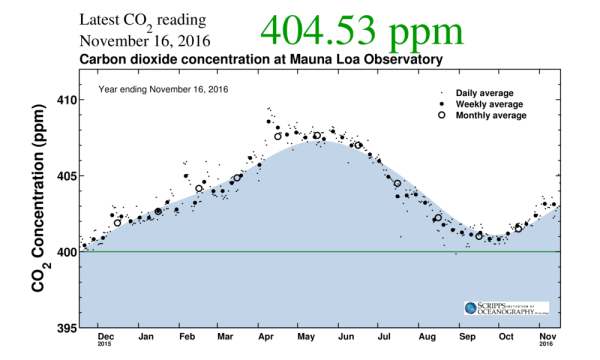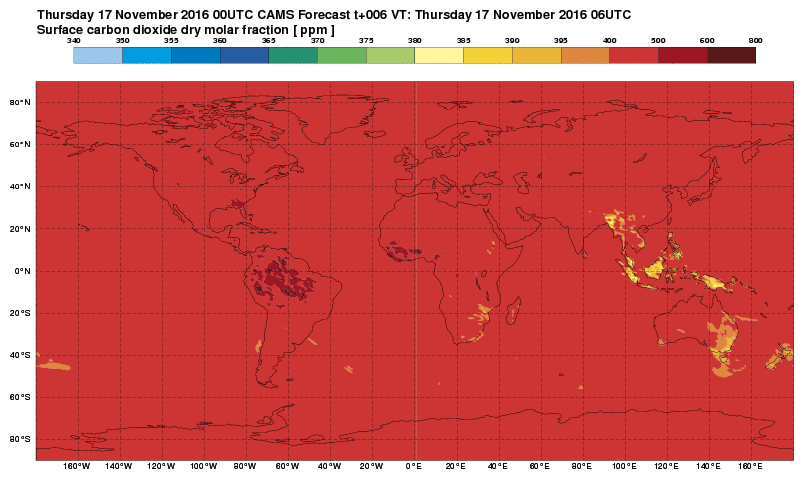Rates of Hothouse Gas Accumulation Continue to Spike as the Amazon Rainforest Bleeds Carbon
18
November, 2016
Back
in June, atmospheric
carbon monitors indicated that the Amazon Rainforest was leeching out
more carbon dioxide than it was taking in.
This is kind of a big deal — because the vast expanse of trees and
vegetation in the Amazon represents a gift nature has given to us.
For all that lush vegetation draws in a considerable amount of carbon
dioxide and stores it in leaves, wood, bark and soil. And this
draw-down, in its turn, considerably reduces the overall rate of
atmospheric carbon accumulation coming from human fossil fuel
burning.
Over
the years and decades, this great service has saved the world from an
even more rapid warming than
it is presently experiencing.
But not even the great forests could stand for long against the
unprecedented plume of carbon coming from human fossil fuel industry.
For the great belching of heat-trapping gas by all the world’s
engines, furnaces, and fires is equal to about 4
or 5 of the Siberian flood basalts that
triggered the worst hothouse extinction event in Earth’s deep
history.
And
so the world has warmed very rapidly regardless of the mighty effort
on the part of forests like the Amazon. And that very heat is now
harming the trees and damaging the earth to which they are wed. For
when soils warm, the carbon they take in is leached out. And along
with the heat comes fires that can, in a matter of minutes, reduce
trees to ash and return the captured heat-trapping carbon to the
world’s airs.
Atmospheric
CO2 Accumulation Increasing Despite Plateau in Human Carbon Emissions
Now
such a destructive process appears to be well under way. And it seems
that an apparent blow-back of greenhouse gasses from one of the
world’s largest carbon sinks is presently ongoing even as rates of
atmospheric carbon dioxide accumulation are spiking. For in
2016,the
world is now on track to see a record annual rate of atmospheric CO2
increase in the range of 3.2 to 3.55 parts per million.
(During
2015, atmospheric CO2 increased by a record annual rate of 3.05 ppm.
This happened during the build-up of one of the strongest El Ninos on
record. But as a weak La Nina settled in during late 2016 and
equatorial Pacific Ocean waters cooled, annual rates of carbon
dioxide accumulation is again on track to hit a new record high.
During mid-November, daily CO2 readings hit above 405 parts per
million. An indication that rates of accumulation had not at all
backed off from present record highs. Image source: The
Keeling Curve.)
This
rapid build-up is occurring despite a shift to La Nina — in which
somewhat cooler ocean surfaces tend to take in more atmospheric
carbon — and despite a
pause in the rate of carbon emissions increase from fossil fuel
related industry around the world.
The
Amazon as Surface Carbon Emissions Hot Spot
Large
equatorial forests like the Amazon are now producing hothouse gasses
rather than taking them in. In the
Copernicus Observatory’s surface
CO2 measure, we
find areas over the Amazon Rainforest where concentrations range
between 500 and 800 parts per million —
or up to nearly double the present average global atmospheric
concentration.
(Very
high surface CO2 concentrations over the Amazon Rainforest and West
Africa are an indication that key global carbon sinks aren’t
functioning. Instead, at least for the period of June through
November of 2016, they appear to be emitting very high volumes of
stored carbon back into the atmosphere. Image source: The
Copernicus Observatory.)
Desertifying
and drying forested regions of West Africa also show rather high
localized surface CO2 spikes. And both areas are among those
displaying highest
total column atmospheric CO2 concentrations.
According to NASA thermal monitoring, wildfires
are also quite extensive in these zones.
Meanwhile, the
global drought monitor indicates
that both the Amazon and West Africa have experienced exceptional
drought, not only for the most recent year, but over the past 4 years
through October of 2016. And it’s the combined drying and
burning that is likely pumping all that carbon out of soils and
forests.
Carbon
Sink Transitioning to Source
During
both 2005 and 2010, scientific
studies found that the Amazon briefly lost its ability to act as a
carbon sink.
Now, it appears that another period of a loss of functioning of the
‘world’s lungs’ has occurred. But in this case, the Amazon, and
parts of West Africa, appear to be consistently emitting carbon
dioxide rather than taking it in.
It
has long been a concern among climate scientists that human carbon
emissions at the rate of nearly 50 billion tons of CO2 equivalent
gasses each year would eventually harm the world’s forests, oceans,
lands, glaciers and permafrost zones’ ability to take in that
unprecedented carbon spike. And here we have at least some indication
that this has happened, at least during 2016 and hopefully not
extending over a longer period.
Links:
Hat
tip to Umbrios
Hat
tip to Andy in San Diego






No comments:
Post a Comment
Note: only a member of this blog may post a comment.